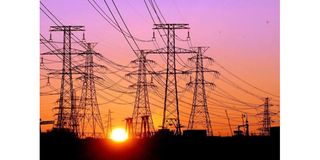What is behind the dramatic return of power blackouts?

What you need to know:
- Tanesco generates power through 44 power generation stations that use either hydropower, gas, diesel, or some other fuel.
After a short-lived reprieve during the Magufuli years, power blackouts are back in style in Tanzania. And they are back with vengeance.
In just one week, I have counted at least a dozen. Talking to a friend in Sinza, he counted close to ten in one day. I guess it is a similar experience which prompted Ambassador Khamis Kagasheki to tweet to Energy minister that ‘power cuts have gone beyond tolerable limits’.
Even those who cannot be accused of being Magufuli fans have to admit that during his days there was a real feeling that the nation was about to turn a corner as far as this issue was concerned. The frequency of power cuts then was counted in weeks and possibly months, not hours and days. And when there was one, often a notice was given beforehand.
What one would give just to receive those nice messages again!
People ask themselves two main questions – one: what causes these blackouts and, two: why the sudden deterioration in the quality of service? To answer these questions, it is desirable to understand how the three components of a power network, that is, power generation, transmission and distribution networks, come together.
Tanesco generates power through 44 power generation stations that use either hydropower, gas, diesel, or some other fuel. The power generated is fed into 48 substations which transmits it to population centres through high-voltage lines, 5,896km in total. The power is ultimately fed into distribution substations, where distribution lines that connect 11,124 transformers that serve about 2.4 million subscribers.
This is a tree-like model with a few nodes at the apex but growing in complexity the closer to the subscribers one gets. Thus, the faults at the generation and transmission levels are relatively few in number but they tend to have a near network wide effect.
In August 2021, SGR contractors ruptured an underground high-voltage line that was feeding Msamvu Substation in Morogoro. There were two main failures. One, a Tanesco officer attached to SGR should have prevented the mishap. Two, the maintenance team at Msamvu should not have made more than three attempts at restoration. Unfortunately they did, with the fourth one causing fire that brought down the national grid.
Infrastructures at these levels are mission-critical and a matter of national security. So, the regional security committee was right in reviewing the security implications. All in all, the gold standard in mission-critical infrastructure is that they ought to be virtually fail-proof.
However, in Tanzania, due to the multiplicity, smallness, unreliability, wear-out and high cost of operation of power stations, and poorly developed transmission infrastructure that often lack redundancy, not infrequently Tanzanians have had to suffer blackouts because of issues that start at these levels. Today, a failure in Iringa, Mufindi, or Makambako, can cause total blackouts in Njombe, Mbeya, and Ruvuma. Billions of dollars are needed to address issues such as this one.
Barring mishaps such as Msamvu’s, most failures at these levels are due to poor planning and investment. They are leadership failures. Given the way Tanzania works, this means it is the president and the minister who are responsible.
The vast majority of faults occur at the distribution level. The reasons are numerous – worn out infrastructure, overloaded or faulty transformers, overheating conductors, fallen poles, limited investment, failure to do preventive maintenance, etc.
One of the most widely touted explanation for what is happening now is the fact that all cutovers were frozen by President Magufuli, thus implying that maintenance is being done now. Admittedly, President Magufuli’s methods were unconventional, and he actually got results in this area, but, in my opinion, this explanation lacks in merit.
Firstly, maintenance is planned – and doesn’t cause sporadic blackouts. Secondly, it is possible to do maintenance without cutting power. Thirdly, in some parts of Dar, sizable projects were done to upgrade poles – but the situation deteriorated afterwards. Fourthly, aging infrastructure doesn’t suddenly affect quality of service for everyone everywhere. Finally, the faults are not on the last mile – we don’t see technicians around.
That doesn’t add up.
In my opinion, the frequent blackouts are most probably caused by:
One, with every new house, office, or event hall, the distribution capacity is being stretched to the limit. Often, power levels are pathetically low – yet new clients are being added. Technically, this is what can cause transformers, conductors, and substations to fail intermittently. This implies no upgrades in substations and transformers.
Two, generation capacity is low. I made this argument in an earlier article, and I stand by my analysis that all indicators show that there is a challenge in capacity. When substations don’t receive enough power, the effects are cascaded to end users.
So, who is responsible for failures at the distribution level?
Ideally, this is an operational matter and Tanesco’s management should be solely responsible. However, the management has limited control of their pricing and cost structures, funds allocation and general investments. So, our political masters are responsible for these blackouts too.
While writing this article, news of the ‘firing’ of Tanesco’s PR and Communication department by Energy minister January Makamba emerged. Unfortunately, that is how the cookie crumbles.
Between the minister and Tanesco’s staff are directors, the MD, and the Board – so how does the minister get to fire people? Why not allow Maharage Chande, the man with no mean management profile – to manage his organisation and hold him responsible for the results?
It is poor appreciation for corporate governance which has brought Tanzania to where she is today. The current state of Tanzania’s state-owned enterprises such as Tanesco closely mirror the quality of governance. So, while Tanzanians curse Tanesco with every breath, those truly responsible for its poor performance may be playing golf elsewhere.





